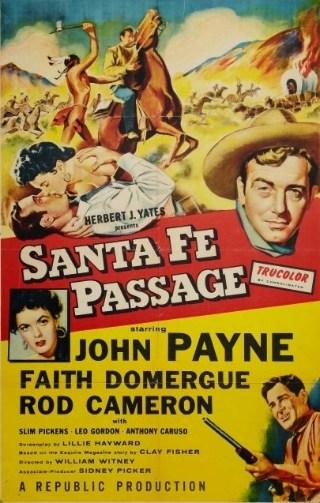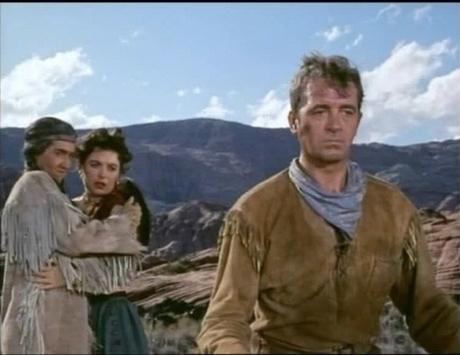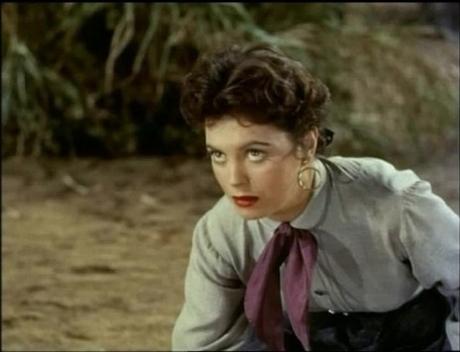
All westerns are about journeys. In some cases this journey is explicit and external, involving some pioneering trip along or beyond the frontier. At other times it’s implicit, an internal or spiritual quest which the hero embarks on leading to the discovery of some truth or a better understanding of himself. As much as anything it’s the setting of the western which lends itself to stories of this type – if you’re going to tell such a tale, then what better time or place to do so than one on the fringes of civilization amid a harsh and primal landscape. For me, when the two concepts of the journey, the external and the internal, coincide the results are almost always satisfying. Santa Fe Passage (1955) is one of those movies, a case of seeing the hero strike out into the wilderness and simultaneously (impelled by circumstances) delving into his own consciousness to confront his preconceptions and prejudices.
It’s always nice to see a movie come charging out of the starting blocks, and that’s precisely what happens here. Two riders are driving their mounts hard over the baked Utah landscape, one clearly in hot pursuit of the other. The quarry, a Kiowa, is soon overtaken and savagely clubbed to the ground with the butt of his pursuer’s rifle. This is Sam Beekman (Slim Pickens), a wagon train scout, and he hauls his captive back to where his partner, Kirby Randolph (John Payne), is waiting with the westbound travelers. With the Kiowa evidently on the warpath, Randolph hits upon what he thinks is a clever ploy, namely distracting the war party with an offer to trade while the wagons roll ahead to safety. However, he miscalculates badly and only discovers later that those he’s responsible for end up massacred and the few survivors left mutilated. If the guilt for this piece of poor judgment weighs heavily on his soul, it’s as nothing compared to the near universal revulsion and hatred the mere utterance of his name invokes. Randolph becomes an outcast among his own and virtually unemployable. Despite all this, he’s presented with a second chance, an opportunity to redeem himself, when a freight outfit needs a scout. Jess Griswold (Rod Cameron) and Aurelie St Clair (Faith Domergue) are taking a shipment of arms to sell in Santa Fe and, even though the latter voices strong objections based on his tarnished reputation, decide to hire Randolph to see them through safely. The trip will be an eventful one, filled with physical dangers and peril, though none quite as challenging as the psychological hurdles the scout is going to have to negotiate along the way.

Over the years, I’ve managed to feature the work of most of the major figures from the classic era of cinema, particularly those who worked in westerns. A notable exception though is William Witney, a director whose critical reputation has gradually grown, no doubt helped by the fact that people like Tarantino have spoken of his work with admiration. Early in his career, Witney worked extensively on serials before moving on to features and thereafter alternating between those and a significant amount of television work. His output was so substantial that I’m sure most people with an interest in classic cinema or TV will have come across examples of his directing at some point. Unsurprisingly, given his background, action and pace were his forte, and Santa Fe Passage certainly packs plenty into its hour and a half running time. There’s a kind of brutal honesty to this movie, something I recall noticing in one of Witney’s later productions Arizona Raiders too, and is particularly noticeable in the scenes depicting the chilling aftermath of the early wagon train massacre. It’s also to be found in the frank presentation of uncomfortable attitudes and how they are addressed and overcome, which I’ll touch on presently, although this aspect probably has its roots in Clay Fisher’s original story. Additionally, the harshly beautiful Utah locations, where the bulk of the action plays out, provide yet another layer of realism to it all.
What raises this picture above the straightforward adventure variety, not that there’s anything wrong such movies of course, is the characterization of the leads. In particular, the roles undertaken by John Payne and Faith Domergue offer a fascinating insight into guilt, bitterness and self-loathing, all sparked by racial stereotyping and the fear of miscegenation. Both characters carry their burden of guilt for different reasons and this threatens to consume them whole. In Payne’s case, the guilt appears to have twisted around and turned in upon itself; the bitterness stemming from his awareness of mistakes made manifests itself in a violent distrust of the Indian, or even anyone of mixed blood. It sets up a wonderful dramatic conflict as it seems to me that his character is galled by his own prejudice even as he indulges in it. One could argue that the resolution, when it comes around, is too pat and convenient but it’s fitting for all that and it does complete the journey the filmmakers have been on. The whole thing also serves to blur the line between hero and villain, especially when Rod Cameron is cast in such an ambiguous role – he’s more understanding and tolerant than Payne yet behaves treacherously, although his motivations in that regard are not entirely ignoble. The net result of all this is that the viewer is forced to think and weigh up the good and bad in all concerned, and that’s never a bad thing.

I think there may be a commercial DVD of Santa Fe Passage available in Italy, though I wouldn’t be too sure about its quality, and it can be viewed easily enough online. So far, it doesn’t appear to have been granted an official release anywhere and, once again, I’m indebted to John Knight for his kind assistance in ensuring I was able to watch a good print of the film. As has been noted before, too many of John Payne’s films remain unavailable and this is one of the best examples, in my opinion. This is a fine mid-50s western, the kind that typically offers plenty of food for thought alongside strong entertainment value. Check it out if you get the chance.
